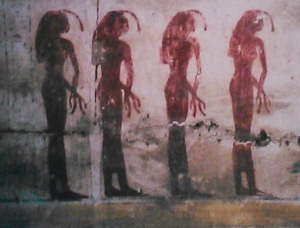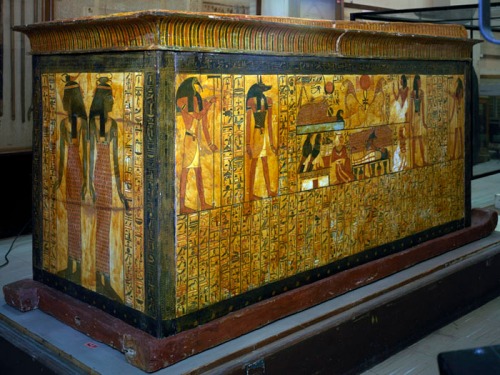Last week we knew that the ancient Egyptian goddess Neith had her reasons for being part of that team of four goddesses-mourners (Isis, Nephtys, Neith and Serket) protecting the dead.

Serket as scorpion. Statue from Late period. Musée du Louvre. Photo: www.museumsart.de
Serket was also a very important divinity in the Egyptian pantheon. She had a great healing power and for that reason she was invoked in ancient Egyptian remedies against scorpion bites.
In the funerary sphere of Ancient Egypt Serket helps the Egyptian solar god in his daily rebirth. Re, during his journey in the darkness of the night has to fight against his enemy, the serpent Apophis, which is facing the solar bark.

Serket killing Apophis. Detail from the tomb od Seti I. XX Dynasty. Photo: www.bibelwissenschaft.de
The Egyptian the Book of the Amduat from the New Kingdom tells how in the seventh hour, which takes place in the Cavern of Osiris, the power of Serket becomes a great help for defeating Apophis. This great serpent had drunk all the water and the solar bark juts could move thanks to the magic of Isis (the magic of Isis helped also Anubis in the mummification process of Osiris). So, Apophis was in the solar sphere of Ancient Egypt the image of chaos. And among the gods who helped Re against his enemies, was Serket, whose power helped in capturing Apophis and dismembering his body.

Serket from the tomb of Khaemwaset. Valley of the Queens. XX Dynasty. Photo: www.corbisimages.com
But Serket appears also associated to the Myth of Osiris. According to a version of the legend Serket helped Isis and Horus the Child when both had to hide from Seth in the marshes. Maybe for that reason Serket appears already mentioned in the Pyramid Texts of Old Kingdom associated with Isis, Neith and “The Two Harmonious Ones” (Pyr. 308).
However, is this link of the goddes with the protection of the dead, which comes from ancient times, related just to these two things we have mentioned?
Next week we will tackle an aspect of goddess Serket, which could make easier to understand her association with the protection of the corpse.





